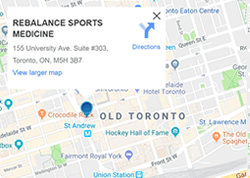Prevention of ACL injuries in Athletes
 ACL ligament injuries to the knee are very common in sport (see Part 1 of this blog post to find out more about ACL injuries). Evidence has shown that the right type of training program and warm up regimen can significantly reduce the risk of ACL injuries in athletes if done correctly and regularly. A good prevention program incorporates repetitive practice of strategies that teach the mind and body how to move and respond appropriately when the body is put into vulnerable positions. Even though these programs are specifically designed to reduce ACL injuries, they can also be beneficial in reducing other injuries as well.
ACL ligament injuries to the knee are very common in sport (see Part 1 of this blog post to find out more about ACL injuries). Evidence has shown that the right type of training program and warm up regimen can significantly reduce the risk of ACL injuries in athletes if done correctly and regularly. A good prevention program incorporates repetitive practice of strategies that teach the mind and body how to move and respond appropriately when the body is put into vulnerable positions. Even though these programs are specifically designed to reduce ACL injuries, they can also be beneficial in reducing other injuries as well.
A comprehensive ACL prevention program will include the following components:
- Active Warm Up
- Flexibility
- Eccentric Strengthening and Plyometrics (Push-off & landing Skills especially on one leg)
- Speed and Strength development (Double and Single Leg)
- Proprioceptive Training (Stability and Balance)
- Agility Training (Acceleration/Deceleration, Change in Directions)
- Cool Down
Below is a break-down of the different components listed above. It is important to understand that all components are critical and without one component, the program will not fulfil the role of ACL risk reduction.
The Active Warm up
The warm-up helps to prepare the muscles, joints and soft tissues for the activity/sport to come. It increases blood circulation and helps to lubricate the joints so they are able to move further.
Examples of exercises that can be included in the active warm up include.
- High knee walking
- Jog line to line
- Shuttle Run
- Backward Running
Flexibility
Stretching can help improve your range of motion, reduce muscular stiffness, reduce onset muscle soreness and reduce injury. It is important to stretch only after your muscles are warmed up. Current research suggests that stretching should be done through movement (aka dynamic stretching).
Examples of stretches that improve flexibility include:
- Calf Stretching
- Stationary Spiderman
- Deep Forward Lunge Walk
- Deep Side Lunging
- Downward Dog with forward crawl
Eccentric Strengthening and Plyometrics
Plyometric exercises are explosive exercises that help improve power, strength and speed. The purpose of this aspect of the program is to teach appropriate push off and landing skills especially with one leg. This is an area where injuries can occur and thus, training the neuro-muscular control for this tasks is pertinent to prevention.
Examples of Eccentric Strengthening and Plyometrics include:
- Split squats
- Bounding
- 2 leg jump squats
- Hopping from one leg to the other
Strength Development
The key to the strengthening portion of the program is to increase leg strength. In turn, increasing leg strength will increase stability in the knees thus lowering the risk of injuries.
Examples of strength development include:
- Lunges
- Deadlifts
- Squats
- Single Leg Squats
- Single Toe Raises
Proprioceptive Training
Proprioception is your bodies ability to run without looking at your feet, throw a ball without looking at your arm and move around with a knowledge of where your limbs and body parts are in space. Proprioceptive receptors trigger muscles to contract and relax to keep you balanced. Practicing sport specific movements listed throughout this article can be helpful to develop and fine tune your proprioception in addition to balance training.
Examples of proprioceptive exercises:
- Single leg balance (eyes open and closed)
- 747 stance (eyes open and closed)
- Single leg balance with limb movements (eyes open and closed)
Agility Training
These exercises are designed to improve co-ordination and the ability to stop, start, change direction, accelerate and decelerate using safe and optimal movement patterns.
Examples of Agility Training Include:
- Shuttle run Forward/Backwards
- Diagonal Runs
- Ladder Drills
Cool Down
Cooling down is a way to slow down the pace and movements that you worked on in your workout. Essential to any workout and therefore should not be skipped. Not performing a proper cool down can cause your muscles to tighten up excessively, thus causing more injuries. The purpose of the cool down is to avoid daily onset muscle soreness (DOMS) and to elongate the muscles that you have just trained.
An excellent ACL prevention program that is commonly cited in the literature is the Santa Monica Orthopaedic and Sports Medicine ACL prevention program. Some of the exercise suggestions above have come from this program. For more details and instruction on how to safely perform the exercises above or to have an individualized prevention program developed for you contact us and book in with one of our physiotherapists or skilled health professionals.
Written By: Giulliano Calleri – Registered Massage Therapist at Rebalance Sports Medicine
Rebalance Toronto
Rebalance Sports Medicine is a multidisciplinary clinic in downtown Toronto offering physiotherapy, chiropractic, registered massage therapy, sports medicine, naturopathy, Pilates and more.



 What to Expect From Your First Physiotherapy Visit
What to Expect From Your First Physiotherapy Visit The Benefits of Fascial Stretch Therapy [Demo]
The Benefits of Fascial Stretch Therapy [Demo] How Does Physiotherapy Work?
How Does Physiotherapy Work? Best Exercises for Low Back Pain
Best Exercises for Low Back Pain